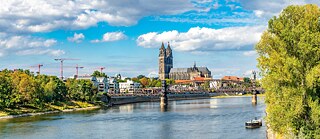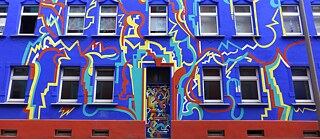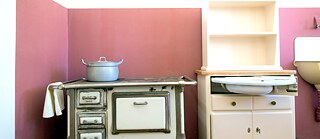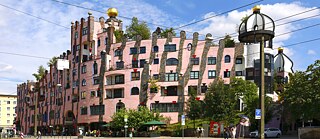Detours | Magdeburg
Brightly coloured beats drab and grey
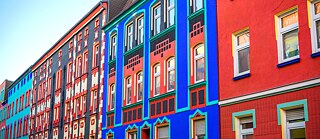
Bauhaus meets East German prefabs and Hundertwasser meets Gothic: Magdeburg is a truly “colourful city”. With two superstars who grew up nearby.
By Daniel Hinz
Lustrous and colourful facades, expressionistic embellishments and windows adorned with decorations – in the 1920s a vision became reality in Magdeburg’s Otto-Richter-Strasse. Drab and grey brick boxes? No, Magdeburg wanted something a bit different: “colour is joie de vivre” was the motto of Bruno Taut, an architect and the city’s planning director. The facades of around 80 buildings in the city centre were redesigned at the time, a colourful approach to construction that characterizes the city to this day.
The brightly coloured facades were just one small aspect of a package of construction activities that transformed the city 100 years ago. Hermann Beims, who was elected mayor in 1919, wanted first and foremost to build new flats that would satisfy people’s “needs for health, wellbeing, sun, healthy air, good nursery school places and green spaces”. In just a few years, several estates were built in the Bauhaus style, including the Herrmann Beims Estate, which comprises some 2,000 apartments. Though not evident from the outside, the interior walls were painted a different colour in every room.
The architectural variety in Magdeburg is impressive: Bauhaus, expressionism, the obligatory East German prefabs – and even Wilhelmine buildings. Such as at Hasselbachplatz, which is also home to the most pubs and the perfect place to stop off for a drink when evening falls in this city on the River Elbe. The city’s most prominent building is probably the cathedral, however, a Gothic church that is a few years older even than Cologne Cathedral and towers above the city centre. The next architectural peculiarity is located just nearby: the Green Citadel, designed by the artist and architect Friedensreich Hundertwasser, has virtually no right angles, featuring curved walls and oblique pillars instead.
Once you’ve sufficiently feasted your eyes on all these architectural contrasts, it’s time to turn your attention to natural beauty. With its lakes, river and parks, it’s easy to see why Magdeburg is said to be one of Germany’s greenest cities – even boasting a summer toboggan run. Built on a former landfill site in the Elbauenpark, it is 452 metres long, allowing you to reach speeds of up to 40 kilometres per hour.
Incidentally, the pop group Tokio Hotel is from Magdeburg. Superstar twins Tom and Bill Kaulitz, who now live in Los Angeles, grew up in a village nearby. Though the two brothers don’t have so many great memories of their time in the city, Bill said in an interview that they still loved the place somehow. It is not only fans of architecture who should come and discover their love for Magdeburg – this city in Saxony-Anhalt with the reputation of a provincial town and the status of a state capital.
Detours
What does Görliwood mean, why can you find a piece of the Caribbean in Bavaria and where can you dance in front of bucket wheel diggers? In our series we take you on a trip each month to somewhere in Germany that you may not yet know but should definitely be introduced to. We reveal places that are not to be found on the usual tourist trails. Are you ready for a bit of a detour?
